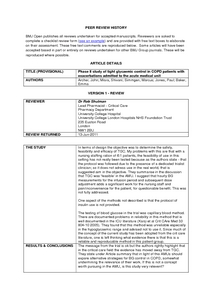Archer, JR; Misra, S; Simmgen, M; Jones, PW; Baker, EH
(2011)
Phase II study of tight glycaemic control in COPD patients with exacerbations admitted to the acute medical unit.
BMJ Open, 1 (1).
e000210.
ISSN 2044-6055
https://doi.org/10.1136/bmjopen-2011-000210
SGUL Authors: Baker, Emma Harriet Jones, Paul Wyatt
![[img]](https://openaccess.sgul.ac.uk/1564/1.hassmallThumbnailVersion/bmjopen-2011-000210.pdf)  Preview |
|
["document_typename_application/pdf; charset=binary" not defined]
Published Version
Download (161kB)
| Preview
|
Abstract
BACKGROUND: Hyperglycaemia is associated with poor outcomes from exacerbations of chronic obstructive pulmonary disease (COPD). Glycaemic control could improve outcomes by reducing infection, inflammation and myopathy. Most patients with COPD are managed on the acute medical unit (AMU) outside intensive care (ICU).
OBJECTIVE: To determine the feasibility, safety and efficacy of tight glycaemic control in patients on an AMU.
DESIGN: Prospective, non-randomised, phase II, single-arm study of tight glycaemic control in COPD patients with acute exacerbations and hyperglycaemia admitted to the AMU. Participants received intravenous, then subcutaneous, insulin to control blood glucose to 4.4-6.5 mmol/l. Tight glycaemic control was evaluated: feasibility, protocol adherence; acceptability, patient questionnaire; safety, frequency of hypoglycaemia (capillary blood glucose (CBG) <2.2 mmol/l and 2.2-3.3 mmol/l); efficacy, median CBG, fasting CBG, proportion of measurements/time in target range, glycaemic variability.
RESULTS: were compared with 25 published ICU studies. Results 20 patients (10 females, age 71 ± 9 years; forced expiratory volume in 1 s: 41 ± 16% predicted) were recruited. Tight glycaemic control was feasible (78% CBG measurements and 89% of insulin-dose adjustments were adherent to protocol) and acceptable to patients. 0.2% CBG measurements were <2.2 mmol/l and 4.1% measurements 2.2-3.3 mmol/l. The study CBG and proportion of measurements/time in target range were similar to that of ICU studies, whereas the fasting CBG was lower, and the glycaemic variability was greater.
CONCLUSIONS: Tight glycaemic control is feasible and has similar safety and efficacy on AMU to ICU. However, as more recent ICU studies have shown no benefit and possible harm from tight glycaemic control, alternative strategies for blood glucose control in COPD exacerbations should now be explored. Trial registration number ISRCTN: 42412334. http://Clinical.Trials.gov NCT00764556.
Statistics
Item downloaded times since 26 Feb 2014.
Actions (login required)
 |
Edit Item |




